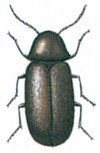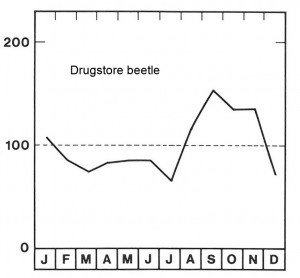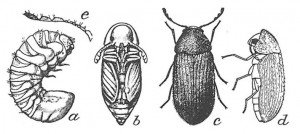

Latin: Stegobium paniceum.
2 – 4 mm long, reddish-brown and hairy. It is widely spread all over the world. It lives in bread. Not freshly baked bread and the like, but the hard baked goods or stale, dry bread. It lives in various products: biscuits, dog biscuits, cookies, cereals, rice, pasta, herbs and pharmaceuticals to name a few. In the old times it was drugstore beetles that sailors had to knock out of sea biscuits. Although its diet seems dry, the bread beetle is not drought tolerant. When the humidity drops below 50-60% RH it is not able to reproduce. At temperatures below 17 ° C reproduction stops completely.
Development from egg to adult takes 2 – 3 months at 22 ° C. Optimal temperatures are between 25 and 28 ° C, wherein a drugstore beetle population may be increased by 7, 5 times per month. That is relatively slow and drugstore beetles rarely do serious damage to goods with a short shelf life. The female drugstore beetle lays 100 eggs and does this directly in goods or in nearby crevices. The newly hatched larvae are only 0.5 mm long, but are very active. They can survive a week without food and are adept at penetrating packaging, which is not sealed completely.

Later, the drugstore beetle larvae become fat and lethargic and they are now quite helpless if they accidentally fall out of the product. The adult beetles do not feed. They are good fliers and seek towards light. You can often find them in windows far from the place where they have gone through their development.




